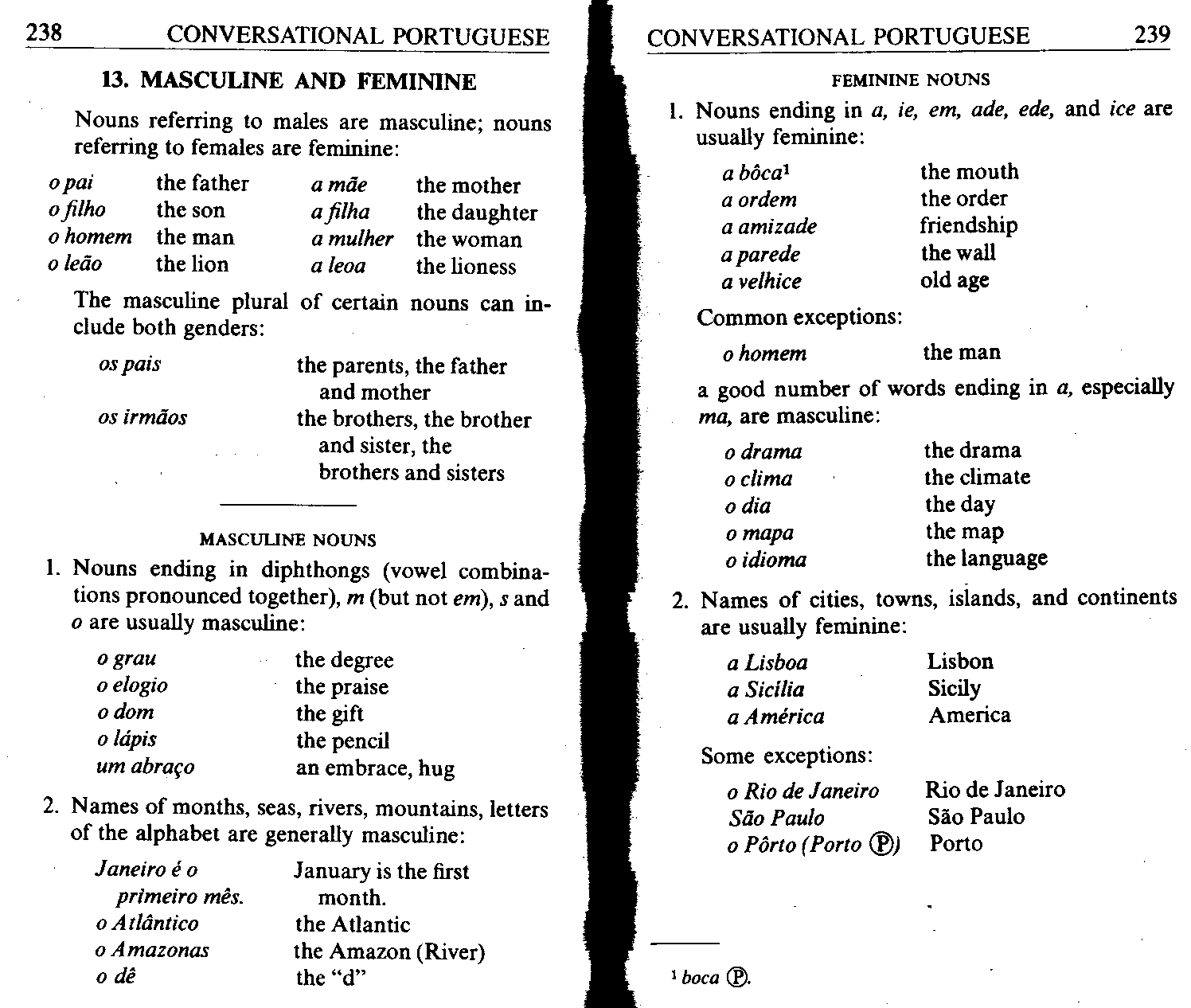Summary p238

238 CONYERSATIONAL PORTUGUESE
13. MASCULINE AND FEMININE
238 CONYERSATIONAL PORTUGUESE
males are masculine; nouns are feminine:
Nouns referring to referring to females
o pai the father
ofilho the son
o homem the man
o leao the lion
a mae the mother
a filha the daughter
a mułher the woman
a leoa the lioness
The masculine plural of certain nouns can m clude both genders:
os pais the parents, the father
and mother
os irmaos the brothers, the brother
and sister, the brothers and sisters
MASCULINE NOUNS
1. Nouns ending in diphthongs (vowel combina-tions pronounced together), m (but not em), s and o are usually masculine:
o grau o ełogio o dom o lapis um abraęo
the degree the praise the gift the pencil an embrace, hug
2. Names of months, seas, rivers, mountains, letters of the alphabet are generally masculine:
Janeiro e o primeiro mes. o Ailantico o Amazonas o de
January is the first month. the Atlantic the Amazon (River) the “d”
FEMININE NOUNS
|
Nouns ending in a, ie, |
, em, ade, ede, and ice are |
|
usually feminine: | |
|
a bócd1 |
the mouth |
|
a ordem |
the order |
|
a amizade |
friendship |
|
a parede |
the wali |
|
a yelhice |
old age |
|
Common exceptions: | |
|
o homem |
the man |
|
a good number of words ending in a, especially | |
|
ma, are masculine: | |
|
o drama |
the drama |
|
o clima |
the climate |
|
o dia |
the day |
|
o mapa |
the map |
|
o idioma |
the language |
|
Names of cities, towns, islands, and continents | |
|
are usually feminine: | |
|
a Lisboa |
Lisbon |
|
a Sicilia |
Sicily |
|
a America |
America |
|
Some exceptions: | |
|
o Rio de Janeiro |
Rio de Janeiro |
|
Sao Paulo |
Sio Paulo |
|
o Porto (Porto |
Porto |
boca ®.
Wyszukiwarka
Podobne podstrony:
In Urdu the entire cosmos is divided into the masculine and feminine genders; the hijras are neither
Summary p234 234 CONYERSATIONAL PORTUGUESE k. with parts of the body and articles of clothing inst
Summary p236 236 CONYERSATIONAL PORTUGUESE De and em combine with the demonstrative forms (see GS2
Summary p274 274 CONYERSATIONAL PORTUGUESE Conjugations II and III pres. subj.:
Summary p284 284 CONYERSATIONAL PORTUGUESE finał a changed to e and finał e changed to a (but also
Summary p310 310 CONYERSATIONAL PORTUGUESE Eleger to elect 1. PAST. PART.! elegido and eleito
Summary p222 222 CONYERSATIONAL PORTUGUESE 21. Vamos_(to have dinner). a. jantar
Summary p224 224 CONYERSATIONAL PORTUGUESE (3) variations occur in different areas: a.
Summary p226 226 CONYERSATIONAL PORTUGUESH CONYERSATIONAL PORTUGUESE 227 d g g h j I I Ut m as d i
Summary p230 230 CONYERSATIONAL PORTUGUESE 3, The cedilla (cedilha) is used with
Summary p240 240 CONYERSATIONAL PORTUGUESE 14. THE PLURAL 1. Nouns ending in a vowel, including na
Summary p242 242 CONYERSATIONAL PORTUGUESE seu can also be used to translate “his,” “her,” “their.
Summary p246 246 CONYERSATIONAL PORTUGUESE 1«. COMPAR1SON 1. Rcgular comparison facil easy ma
Summary p248 248 CONYERSATIONAL PORTUGUESE 19. PRONOUNS Pronouns have varying forms depending on w
Summary p250 250 CONYERSATIONAL PORTUGUESE CONYERSATIONAL PORTUGUESE_ 251 (te) I
Summary p252 252 CONYERSATIONAL PORTTJGUESE For morę Information and example$, s
Summary p254 254 CONYERSATIONAL PORTUGUESE Nao me escreva mais. Eles decidiram que nos mandar
Summary p256 256 CONYERSATIONAL PORTUGUESE 21. SOME CONJUNCTIONS ainda que assim que ate
Summary p258 258 CONYERSATIONAL PORTUGUESE 23. ADYERBS 1. Some Portuguese adverbs are formed by ad
więcej podobnych podstron